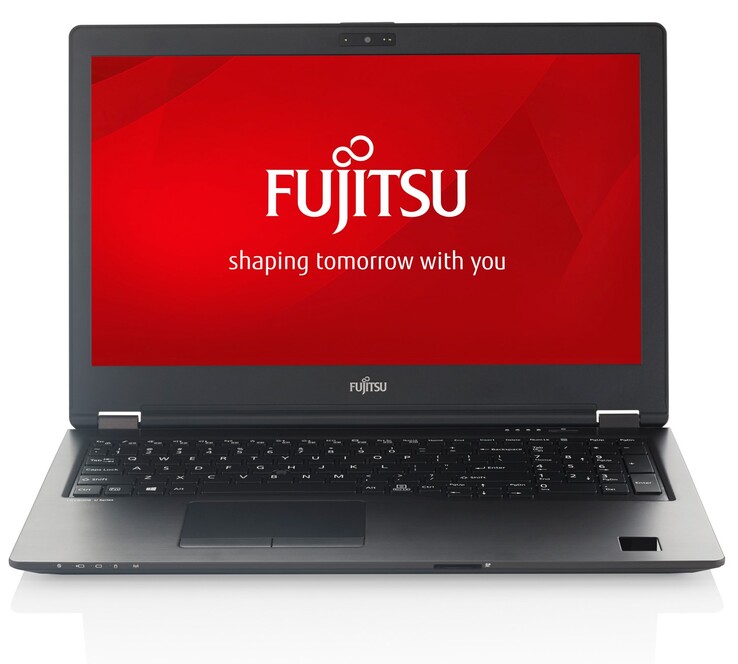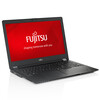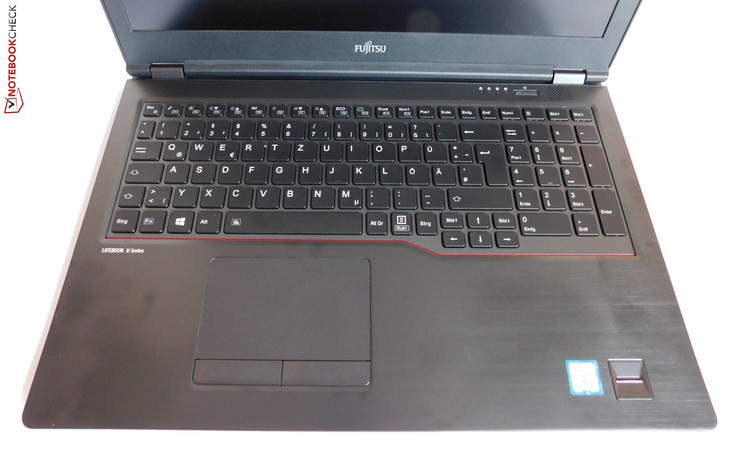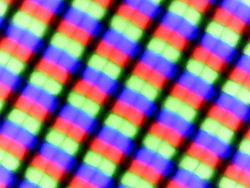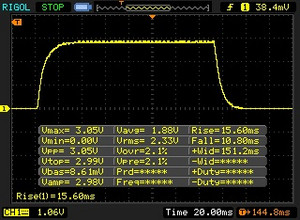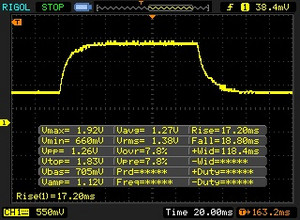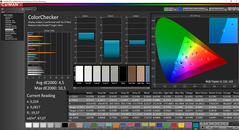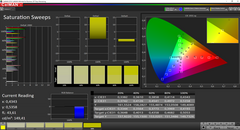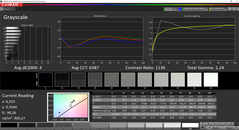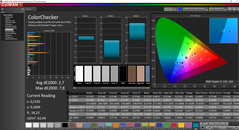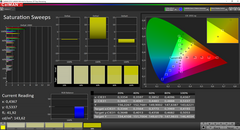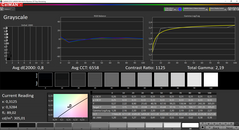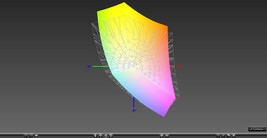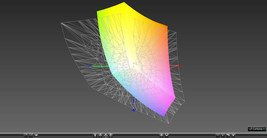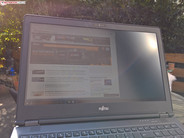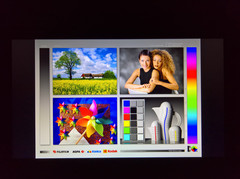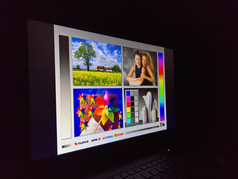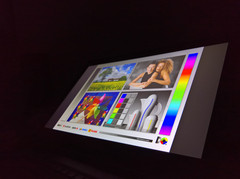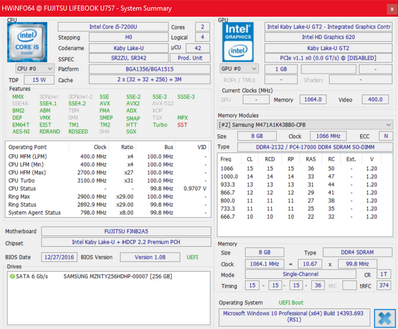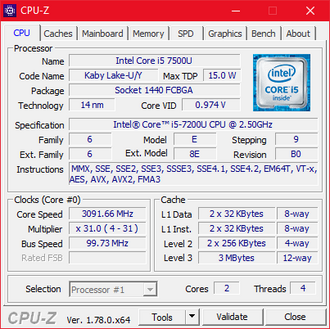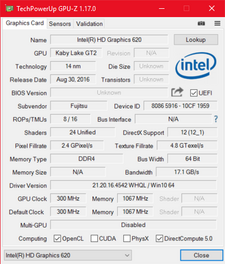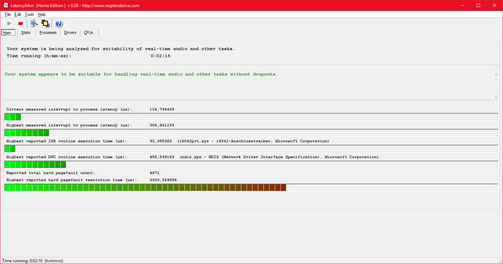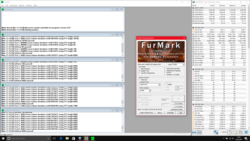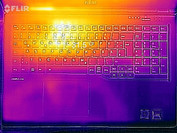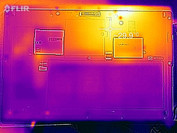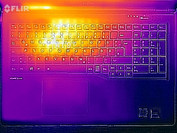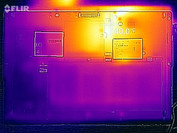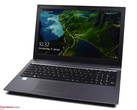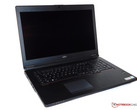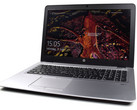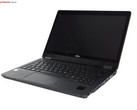Fujitsu LifeBook U757 (7200U, FHD) Laptop Review

For the original German review, see here.
After recently having tested the 14-inch sister model, we now look at the Lifebook U757 which is the 15-inch counterpart in Fujitsu's Lifebook U series - an upper-range business laptop lineup. The U757 is the first 15-inch model of this series that we have tested. Thus, unlike in the U747, we cannot make any comparisons to a predecessor.
15-inch laptops are generally not found as often in business environments as among private customers. This becomes apparent when taking Dell as one of the leading manufacturers in this sector as an example. Dell does not offer any 15-inch models in its expensive Latitude 7000 lineup, and thus we use the Latitude E5570 for comparison instead. At least both other leading business laptop manufacturers have comparable models: Lenovo's ThinkPad T570 and HP's EliteBook 850 G4 are in the same league as the Lifebook U757. We also use Acer's TravelMate P568 for comparison.
As was the case in the test of the Lifebook U747, we are testing the cheapest model of the series. Our review sample is furnished with an Intel Core i5, 8 GB of RAM, and a 256-GB SSD.
Case
Only the different size discerns the U747 from U757 on the outside. Both follow the same design concepts: A black-gray casing with an extremely beveled front. The materials are also identical. Fujitsu uses the same metal combination of brushed aluminum for the wrist rest, and magnesium for the display lid and base. Thus, the U757's stiffness is similar to that of the smaller model, which is pretty good. However, the 14-inch device has a slight advantage due to the somewhat bigger surface area at the same thickness. Unfortunately, not all good qualities of the U747 have been transferred to the U757. We found a sharp edge on the base's rear. Although the hinges of the U757 operate smoothly, the lid cannot be opened with one hand. They cannot prevent a certain degree of rocking, either.
Connectivity
The interfaces largely correspond to the ones in the smaller model. However, Fujitsu additionally installs an HDMI port here. It is too bad that the bigger, 15-inch size is not used better - for example, by adding a third USB Type-A port since only two of these ports in a 15-inch model is rather poor. All ports are positioned well though the HDMI and Ethernet are a bit close to each other.
The U757, being a business laptop, has some security features, such as a swipe fingerprint scanner and TPM. The Lifebook is also optionally available with a SmartCard reader and PalmSecure vein scanner - our model has neither feature.
The Wi-Fi test did not present any major irregularities. The installed Intel 8265 provides a very good performance also in routine use. In addition to Wi-Fi, the device with the EM7305-LTE card also features WWAN. The corresponding slot is under the battery. The SD card reader is not exactly one of the fastest models, but it is not one of the slowest ones, either. It places itself within the same range as the reader installed in the U747 in the benchmark with the Toshiba Exceria Pro SDXC 64 GB UHS-II reference memory card.
| SD Card Reader | |
| average JPG Copy Test (av. of 3 runs) | |
| Dell Latitude 15 E5570 | |
| Fujitsu LifeBook U757 | |
| Lenovo ThinkPad T570-20H90002GE | |
| HP EliteBook 850 G4-Z2W86ET | |
| Acer TravelMate P658-M-537B | |
| maximum AS SSD Seq Read Test (1GB) | |
| Lenovo ThinkPad T570-20H90002GE | |
| HP EliteBook 850 G4-Z2W86ET | |
| Fujitsu LifeBook U757 | |
| Networking | |
| iperf3 transmit AX12 | |
| Lenovo ThinkPad T570-20H90002GE | |
| HP EliteBook 850 G4-Z2W86ET | |
| Fujitsu LifeBook U757 | |
| iperf3 receive AX12 | |
| Fujitsu LifeBook U757 | |
| Lenovo ThinkPad T570-20H90002GE | |
| HP EliteBook 850 G4-Z2W86ET | |
Input Devices
The keyboard and touchpad are almost identical with those of the smaller sister model. The difference is that a numpad is installed here, which the smaller model does not have due to the limited width. Thus, the number pad is an important difference in both models.
Since the input devices are the same, the U757 also adopts both the good and the bad qualities of the U747. To be precise, all keys have a sufficient size, the keyboard's feedback is pleasant, and it has a backlight. In return, the touchpad is inferior. Particularly, the touchpad keys are noticed just as unfavorably as in the other Lifebook. It is beyond comprehension why Fujitsu makes cutbacks here of all places. A TouchStick is not incorporated into our U757, but like in the U747, it is present in some models. It should be noted that the TouchStick does not have dedicated keys and the keyboard, according to the spec sheet, is then neither backlit nor splash-water proof.
Display
Fujitsu offers four different screen options: HD (1366x768) TN, Full HD (1920x1080) IPS, Full HD IPS touch, and UHD (3840x2160) IPS. Only two options are currently available in Germany: Full HD and Full HD touch. The latter is installed in the more expensive model of the series. Consequently, the non-touch Full HD is installed into our model. Fujitsu promises a brightness of 300 cd/m². Just like in the smaller U747, Fujitsu installs an LG panel here. Interestingly, it is exactly the same screen model as in Acer's rival.
This makes the comparison especially interesting since it reveals the differences between two identical screens. The screen in the TravelMate is much brighter while the average brightness of the panel in the Lifebook remains just below 300 cd/m². In return, it has a much higher contrast and better brightness distribution. Although the TN screen in HP's EliteBook 850 G4 is brighter, it cannot compete here because it is inferior otherwise (incl. PWM). The ThinkPad T570 also has a somewhat worse Full HD IPS panel. The low-cost screen in Dell's Latitude E5570 (HD TN panel) does not compare to the competition.
| |||||||||||||||||||||||||
Brightness Distribution: 84 %
Center on Battery: 310 cd/m²
Contrast: 1159:1 (Black: 0.27 cd/m²)
ΔE ColorChecker Calman: 4.5 | ∀{0.5-29.43 Ø4.78}
ΔE Greyscale Calman: 4 | ∀{0.09-98 Ø5}
84.74% sRGB (Argyll 1.6.3 3D)
55.3% AdobeRGB 1998 (Argyll 1.6.3 3D)
62% AdobeRGB 1998 (Argyll 3D)
84.8% sRGB (Argyll 3D)
65.8% Display P3 (Argyll 3D)
Gamma: 2.24
CCT: 6387 K
| Fujitsu LifeBook U757 LP156WF6-SPP1, , 1920x1080, 15.6" | Lenovo ThinkPad T570-20H90002GE N156HCA-EAA, , 1920x1080, 15.6" | HP EliteBook 850 G4-Z2W86ET AUO35ED, , 1920x1080, 15.6" | Dell Latitude 15 E5570 LG Philips 156WHU, , 1366x768, 15.6" | Acer TravelMate P658-M-537B LG Philips LGD04D5 / LG Display LP156WF6-SPP1, , 1920x1080, 15.6" | |
|---|---|---|---|---|---|
| Display | -27% | -7% | -33% | 1% | |
| Display P3 Coverage (%) | 65.8 | 44.08 -33% | 56.8 -14% | 40.48 -38% | 66.6 1% |
| sRGB Coverage (%) | 84.8 | 65.6 -23% | 83.7 -1% | 60.9 -28% | 85.7 1% |
| AdobeRGB 1998 Coverage (%) | 62 | 45.66 -26% | 58.7 -5% | 41.82 -33% | 62.8 1% |
| Response Times | 3% | 6% | -17% | -1% | |
| Response Time Grey 50% / Grey 80% * (ms) | 36 ? | 41.6 ? -16% | 47.2 ? -31% | 47 ? -31% | 38 ? -6% |
| Response Time Black / White * (ms) | 26.4 ? | 20.8 ? 21% | 15.2 ? 42% | 27 ? -2% | 25 ? 5% |
| PWM Frequency (Hz) | 26040 ? | 199.2 ? | |||
| Screen | -6% | -69% | -61% | -16% | |
| Brightness middle (cd/m²) | 313 | 262 -16% | 338 8% | 228 -27% | 308 -2% |
| Brightness (cd/m²) | 294 | 245 -17% | 341 16% | 236 -20% | 319 9% |
| Brightness Distribution (%) | 84 | 89 6% | 90 7% | 90 7% | 71 -15% |
| Black Level * (cd/m²) | 0.27 | 0.24 11% | 0.81 -200% | 0.56 -107% | 0.61 -126% |
| Contrast (:1) | 1159 | 1092 -6% | 417 -64% | 407 -65% | 505 -56% |
| Colorchecker dE 2000 * | 4.5 | 4.5 -0% | 10.9 -142% | 10.02 -123% | 4.51 -0% |
| Colorchecker dE 2000 max. * | 10.5 | 10.5 -0% | 18.7 -78% | 15.93 -52% | 10.19 3% |
| Greyscale dE 2000 * | 4 | 3.5 12% | 13.3 -233% | 10.66 -167% | 2.91 27% |
| Gamma | 2.24 98% | 2.32 95% | 2.11 104% | 2.48 89% | 2.4 92% |
| CCT | 6387 102% | 6524 100% | 16030 41% | 11800 55% | 6740 96% |
| Color Space (Percent of AdobeRGB 1998) (%) | 55.3 | 42.04 -24% | 53.8 -3% | 39 -29% | 56 1% |
| Color Space (Percent of sRGB) (%) | 84.74 | 65.4 -23% | 83.4 -2% | 61 -28% | 86 1% |
| Total Average (Program / Settings) | -10% /
-9% | -23% /
-47% | -37% /
-50% | -5% /
-10% |
* ... smaller is better
Display Response Times
| ↔ Response Time Black to White | ||
|---|---|---|
| 26.4 ms ... rise ↗ and fall ↘ combined | ↗ 15.6 ms rise | |
| ↘ 10.8 ms fall | ||
| The screen shows relatively slow response rates in our tests and may be too slow for gamers. In comparison, all tested devices range from 0.1 (minimum) to 240 (maximum) ms. » 65 % of all devices are better. This means that the measured response time is worse than the average of all tested devices (20.2 ms). | ||
| ↔ Response Time 50% Grey to 80% Grey | ||
| 36 ms ... rise ↗ and fall ↘ combined | ↗ 17.2 ms rise | |
| ↘ 18.8 ms fall | ||
| The screen shows slow response rates in our tests and will be unsatisfactory for gamers. In comparison, all tested devices range from 0.165 (minimum) to 636 (maximum) ms. » 49 % of all devices are better. This means that the measured response time is worse than the average of all tested devices (31.6 ms). | ||
Screen Flickering / PWM (Pulse-Width Modulation)
| Screen flickering / PWM not detected | ||
In comparison: 53 % of all tested devices do not use PWM to dim the display. If PWM was detected, an average of 8108 (minimum: 5 - maximum: 343500) Hz was measured. | ||
The screen can reproduce approximately the same number of colors as the lineup's 14-inch model with almost 85% of the sRGB color space. The same is also true here: Not a bad rate, but 90-100% sRGB would have been desirable for image editing. At least the screen makes a very good subjective impression. It reproduces the colors very naturally with our free ICC profile.
This praise can also be unconditionally passed on to the viewing angles. However, a somewhat higher brightness would have been nice for outdoor use in order to defy the sun more successfully. The screen principally does a good outdoor job thanks to its matte surface, and the panel can be used very well in the shade.
Performance
Three models of the U757 are available on the German market. Two are furnished with 8 GB of DDR4 2133 RAM (upgradable to 32 GB, one slot empty), and the third and most expensive model comes with 16 GB ex-factory. Only the cheapest model that we are testing is furnished with a 256-GB SSD; the other models sport a 512-GB SSD. While all devices are equipped with the same iGPU (Intel HD 620), there are differences in the CPU. Intel's Core i5-7200U is inside our model. Both more expensive models contain the Core i7-7600U, which is the flagship of the U lineup.
Processor
The Core i5-7200U is a mid-range processor in Intel's U lineup. These are chiefly frugal ULV chips with a TDP of 15 watts. Although they were actually designed for ultrabooks, many bigger laptops are now furnished with these processors. All U processors have two cores; our model offers 4 threads thanks to Hyperthreading, and it clocks at up to 3.1 GHz also on two cores (base clock: 2.5 GHz). More comparisons can be found in the CPU benchmark list.
The U757 can maintain its full 3.1 GHz in the multi-core test as only minor fluctuations are recorded even in the 30-minute benchmark loop. The benchmark score reflects this: The CPU's performance is ideally utilized, and the Lifebook makes a good impression compared with its rivals. The older i5-6200U in Acer's TravelMate P568, for example, clearly lags behind.
The same performance is available in battery mode as in AC mode.
System Performance
The U757 places itself between both Skylake comparison devices in the PCMark 8 test. Interestingly, the EliteBook 850 G4 cannot compete here. The Lifebook's work speed is impeccable in everyday use even if the SSD is not one of the fastest models.
| PCMark 8 - Home Score Accelerated v2 | |
| HP EliteBook 850 G4-Z2W86ET | |
| Lenovo ThinkPad T570-20H90002GE | |
| Acer TravelMate P658-M-537B | |
| Fujitsu LifeBook U757 | |
| Dell Latitude 15 E5570 | |
| PCMark 8 Home Score Accelerated v2 | 3320 points | |
Help | ||
Storage Device
Fujitsu installs an SSD by Samsung into the Lifebook. To be more precise, it is the CM871a with a capacity of 256 GB and it is a SATA III SSD in the 2280 M.2 form factor. The U757 is optionally available with PCIe SSDs and they can be retrofitted. This is recommended to users who want the best possible performance as the CM871a is relatively slow even among the SATA III SSDs. However, the SSDs in the rivals by Dell and Acer are even slower. Lenovo and HP install more expensive PCIe SSDs that are considerably faster. More information about the different SSD models can be found in our SSD/HDD benchmark section.
It should also be possible to install a 2.5-inch SSD HDD into the Lifebook. However, the M.2 SSD apparently has to be removed from the system since it is inserted in a caddy in the 2.5-inch slot. Thus, two SSDs cannot be installed at the same time.
| Fujitsu LifeBook U757 Samsung CM871a MZNTY256HDHP | Lenovo ThinkPad T570-20H90002GE Samsung PM961 MZVLW256HEHP | HP EliteBook 850 G4-Z2W86ET Samsung PM951 NVMe MZVLV256 | Dell Latitude 15 E5570 Samsung SSD PM871 MZ7LN128HCHP | Acer TravelMate P658-M-537B Kingston RBU-SNS8152S3256GG2 | |
|---|---|---|---|---|---|
| CrystalDiskMark 3.0 | 98% | 34% | -26% | -20% | |
| Read Seq (MB/s) | 509 | 1318 159% | 1245 145% | 474.7 -7% | 479.1 -6% |
| Write Seq (MB/s) | 488.4 | 1166 139% | 298.6 -39% | 155 -68% | 333.1 -32% |
| Read 512 (MB/s) | 414.3 | 933 125% | 673 62% | 393.6 -5% | 418 1% |
| Write 512 (MB/s) | 321.7 | 860 167% | 298.8 -7% | 119.7 -63% | 320.5 0% |
| Read 4k (MB/s) | 36.43 | 56.6 55% | 41.79 15% | 34 -7% | 25.66 -30% |
| Write 4k (MB/s) | 88.4 | 130.6 48% | 138.4 57% | 96.6 9% | 64.7 -27% |
| Read 4k QD32 (MB/s) | 402.8 | 510 27% | 495 23% | 383.3 -5% | 226.2 -44% |
| Write 4k QD32 (MB/s) | 256.7 | 426.4 66% | 297.5 16% | 100.2 -61% | 211.4 -18% |
Graphics Card
Intel's HD Graphics 620 cannot completely utilize its full potential in the Lifebook U757. This is due to the working memory as the integrated GPU (GT2 expansion stage with 24 execution units) does not have a dedicated memory and thus has to use that of the working memory. Although it has enough capacity, only one module is installed ex-factory. The GPU could retrieve an even higher performance by installing a second module thanks to the then higher memory bandwidth. This way, it lags behind the former HD 520 GPU in Acer's TravelMate P658 in the 3DMark 11 benchmark. Comparisons with other mobile GPUs are possible via our benchmark list.
Test runs with the OpenGL part of the Cinebench 15 benchmark did not lead to any performance reductions.
| 3DMark 11 - 1280x720 Performance GPU | |
| Lenovo ThinkPad T570-20H90002GE | |
| HP EliteBook 850 G4-Z2W86ET | |
| Acer TravelMate P658-M-537B | |
| Fujitsu LifeBook U757 | |
| Dell Latitude 15 E5570 | |
| 3DMark 11 Performance | 1436 points | |
Help | ||
Gaming Performance
Playing games on the U757 should not even be considered. It would only be conditionally suitable for games even if a second RAM module was installed. Of course, it is not designed for this purpose, but it would have been nice if Fujitsu at least offered a dedicated GPU optionally. The other manufacturers offer this option for their 15-inch business models, for example: The GeForce 940M for Acer's TravelMate P658 or the GeForce 940MX for the ThinkPad T570.
| low | med. | high | ultra | |
|---|---|---|---|---|
| BioShock Infinite (2013) | 41.62 | 24.13 | 19.76 |
Emissions and Energy Management
System Noise
Thanks to the generous casing and the frugal CPU, the U757 is almost completely noiseless when idle and during low load. The fan occasionally spins when the laptop is loaded a bit more, but it is not quite as high-pitched as in the U747. The fan remains relatively restrained even during full load.
However, the unpleasant whistling and hissing noise that were occasionally produced during the test should not be left unmentioned. As they were mainly noticed when the SSD was working, we suspect that it is the noise source. It is too bad and unnecessary that such problems occur even in expensive laptops time and again. This not only applies to Fujitsu but to the other manufacturers, as well.
Noise level
| Idle |
| 28.2 / 28.2 / 28.2 dB(A) |
| Load |
| 33.3 / 34 dB(A) |
 | ||
30 dB silent 40 dB(A) audible 50 dB(A) loud |
||
min: | ||
Temperature
What has been said about the system noise can also be said for the temperatures: The energy-efficient components produce not only a quiet but also a cool operation. The device hardly heats up palpably in routine use. We naturally measure slightly higher rates during load, but the temperature increases are also within limits here.
A similarity to the U747 is found when the review sample is loaded with Prime95 and FurMark simultaneously. However, this is common among many laptops with ULV CPUs: The CPU can maintain its Turbo speed of 3.1 GHz for a very short time (approx. 40 seconds). The clock then drops to the base frequency of 2.5 GHz. The temperatures are not the limiting factor here as they do not even reach 80 °C (176 °F) on the CPU, but the CPU's maximum thermal design power. The TDP of 15 watts is simply not enough to utilize the GPU and CPU Turbo at the same time. Since the base clock is not undercut, it is not throttling. The stress test outcomes are uncritical for everyday use.
(±) The maximum temperature on the upper side is 42 °C / 108 F, compared to the average of 34.3 °C / 94 F, ranging from 21.2 to 62.5 °C for the class Office.
(+) The bottom heats up to a maximum of 38.8 °C / 102 F, compared to the average of 36.8 °C / 98 F
(+) In idle usage, the average temperature for the upper side is 23.6 °C / 74 F, compared to the device average of 29.5 °C / 85 F.
(+) The palmrests and touchpad are cooler than skin temperature with a maximum of 23.3 °C / 73.9 F and are therefore cool to the touch.
(+) The average temperature of the palmrest area of similar devices was 27.6 °C / 81.7 F (+4.3 °C / 7.8 F).
Speakers
There is not much to say about the speakers. Fujitsu installs two little stereo speakers above the keyboard that deliver an abysmal performance. They are fairly quiet even at maximum volume, the sound makes a very muffled impression, and low tones are almost completely absent. If possible, they should not be used and external speakers or headphones should be connected instead.
Fujitsu LifeBook U757 audio analysis
(-) | not very loud speakers (68 dB)
Bass 100 - 315 Hz
(-) | nearly no bass - on average 16.4% lower than median
(±) | linearity of bass is average (7.5% delta to prev. frequency)
Mids 400 - 2000 Hz
(±) | higher mids - on average 5.5% higher than median
(±) | linearity of mids is average (9.7% delta to prev. frequency)
Highs 2 - 16 kHz
(+) | balanced highs - only 4.4% away from median
(±) | linearity of highs is average (8.7% delta to prev. frequency)
Overall 100 - 16.000 Hz
(±) | linearity of overall sound is average (26.6% difference to median)
Compared to same class
» 82% of all tested devices in this class were better, 6% similar, 12% worse
» The best had a delta of 7%, average was 21%, worst was 53%
Compared to all devices tested
» 81% of all tested devices were better, 4% similar, 15% worse
» The best had a delta of 4%, average was 24%, worst was 134%
Apple MacBook 12 (Early 2016) 1.1 GHz audio analysis
(+) | speakers can play relatively loud (83.6 dB)
Bass 100 - 315 Hz
(±) | reduced bass - on average 11.3% lower than median
(±) | linearity of bass is average (14.2% delta to prev. frequency)
Mids 400 - 2000 Hz
(+) | balanced mids - only 2.4% away from median
(+) | mids are linear (5.5% delta to prev. frequency)
Highs 2 - 16 kHz
(+) | balanced highs - only 2% away from median
(+) | highs are linear (4.5% delta to prev. frequency)
Overall 100 - 16.000 Hz
(+) | overall sound is linear (10.2% difference to median)
Compared to same class
» 7% of all tested devices in this class were better, 2% similar, 91% worse
» The best had a delta of 5%, average was 18%, worst was 53%
Compared to all devices tested
» 4% of all tested devices were better, 1% similar, 94% worse
» The best had a delta of 4%, average was 24%, worst was 134%
Frequency diagram in comparison (checkboxes above can be turned on/off!)
Power Consumption
Kaby Lake seems to be a bit more energy-efficient than Skylake. Both Skylake models, Acer's TravelMate P568 more than Dell's Latitude E5570, are inferior particularly when idle. HP's EliteBook 850 G4 is even more energy-efficient than the U757, but not during load. This is also true for Lenovo's ThinkPad T570 that consumes the most power among all comparison devices during load.
| Off / Standby | |
| Idle | |
| Load |
|
Key:
min: | |
| Fujitsu LifeBook U757 HD Graphics 620, i5-7200U, Samsung CM871a MZNTY256HDHP | Lenovo ThinkPad T570-20H90002GE HD Graphics 620, i5-7200U, Samsung PM961 MZVLW256HEHP | HP EliteBook 850 G4-Z2W86ET HD Graphics 620, i5-7200U, Samsung PM951 NVMe MZVLV256 | Dell Latitude 15 E5570 HD Graphics 520, 6300U, Samsung SSD PM871 MZ7LN128HCHP | Acer TravelMate P658-M-537B HD Graphics 520, 6200U, Kingston RBU-SNS8152S3256GG2 | |
|---|---|---|---|---|---|
| Power Consumption | -7% | 6% | -1% | -36% | |
| Idle Minimum * (Watt) | 3.96 | 3.6 9% | 3.58 10% | 4.5 -14% | 6.6 -67% |
| Idle Average * (Watt) | 7.74 | 7.7 1% | 5.97 23% | 7.6 2% | 10.4 -34% |
| Idle Maximum * (Watt) | 8.64 | 8.2 5% | 6.81 21% | 8.7 -1% | 12.7 -47% |
| Load Average * (Watt) | 28.8 | 30.8 -7% | 29.4 -2% | 28.5 1% | 36 -25% |
| Load Maximum * (Watt) | 32 | 46.1 -44% | 39.7 -24% | 29.2 9% | 35 -9% |
* ... smaller is better
Battery Runtime
Astonishingly, the Lifebook does not provide good battery runtimes despite its good consumption rates. Although its 50-Wh lithium-polymer battery is not exactly big for a 15-inch model, the rivals' edge on the Lifebook is surprisingly big. Fujitsu should have actually installed a bigger battery here because the battery capacity is the same here as in the smaller U747 despite the larger casing.
| Battery Runtime - WiFi Websurfing | |
| Dell Latitude 15 E5570 | |
| HP EliteBook 850 G4-Z2W86ET | |
| Acer TravelMate P658-M-537B | |
| Lenovo ThinkPad T570-20H90002GE | |
| Fujitsu LifeBook U757 | |
Pros
Cons
Verdict
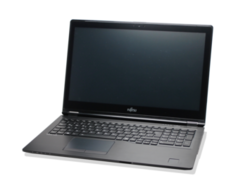
The two new Lifebook U models that we now have had in our test are very similar. The U757 seems to be a bigger version of the U747 in many aspects, and thus it adopts the good and bad properties of the smaller model: good screen, comfortable keyboard, decent casing. Primarily the bad touchpad contrasts this. The fan noise of the U757 is somewhat more agreeable than that of the smaller model, but it produces noises that presumably come from the SSD.
The biggest point of criticism on the U757 compared with the smaller model is that Fujitsu has not used the opportunity to really let the 15-inch model be autonomous and use the advantages of the larger size effectively. The numpad, an optionally usable 2.5-inch HDD/SSD slot, an additional HDMI port, and an optional (currently not installed in any German model) UHD screen are the only things that actually discern the U757 from the U747. More would have been possible in other places: Two USB Type-A ports are, for example, rather poor for a 15-inch business laptop, the 50-Wh battery is relatively small (the same size as in the smaller model), and a dedicated GPU that could be installed into the U757 thanks to the additional space is not offered optionally, either.
The U757 does not differ enough from its smaller sister model, and thus we recommend the smaller model when selecting a Lifebook from Fujitsu's U series. Its size makes daily handling more pleasant.
Thus, the U757 is ultimately a bigger copy of the U747. If the hardware of the Lifebook U series is appealing, the buyer should opt for the U747. The bigger model only has an advantage when a numpad or a bigger screen is needed. The optional UHD model is currently not available in Germany. The competition has some interesting devices in this sector; in particular, the ThinkPad T570 that is currently being tested might be a strong rival. HP's EliteBook 850 G4 (also being tested) is also a good competitor.
Fujitsu LifeBook U757
- 03/20/2017 v6 (old)
Benjamin Herzig




